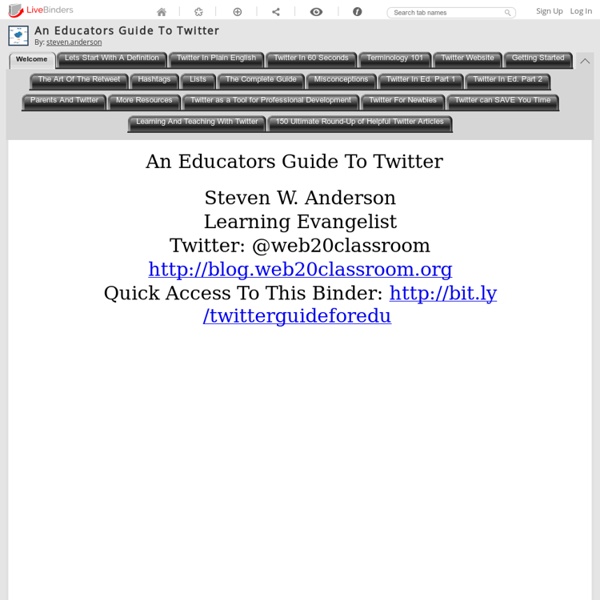



A Beginner's Guide to Twitter Many of ReadWriteWeb’s readers are old hands at Twitter, but the service gets thousands of new users every day. That includes a lot of folks who suddenly need to use Twitter as part of their job. If you’re just being introduced to the joys of Twitter (or introducing it to another user), here’s a short and friendly primer on what you need to know about using the site. After posting “10 Tips on Using Twitter Wisely” in December, I had a few notes from folks who said (basically) “thanks for the tips, but I didn’t know all the jargon.” Digging deeper, I realized that what seems obvious after using Twitter for several years isn’t so obvious to new users. Alphabet Soup Tech folks tend to love acronyms and jargon. Follow If you’re on Twitter you probably get this one already, but let’s cover it for the sake of completeness. Why 140 Characters? Believe it or not, there is a logical reason behind the 140 character limit. Why not 160? How to Tweet You know how to tweet, right? Clients
10 Best URL Shorteners and why they are good URL shortening services are used by millions of people on daily basis as they a serve very important purposes in areas like social networking and internet marketing and are extremely useful in Internet conversations on services like twitter when someone want to share a link. With only 140 characters available to deliver the message a normal link can take up most of the space. Besides shrinking URLs some of the services provide features that can be more useful than you may think. If you are not aware of the possibilities keep reading. Advertisement What is a URL shortener A URL shortener is an online application that allows the user to enter a full URL for any specific web page, click on a button, and automatically shortens a long wordy URL to a short domain name and uses a 5 or 6 character code. Where URL Shorteners are useful First, it’s very useful for micro bloggers, such as Twitter users, who like to share URLs in their posts. List of useful URL Shorteners to try out 1.
Twitter_At_A_Glance - IMPROVED! Twitter for Teachers Loading... If you only have five minutes to spare, this is the one to watch. Educator Marc-André Lalande (@malalande) makes the case for Twitter in education, while keeping it light and fun. I highly recommend it, and not just because @Edutopia is mentioned ;-) by Marc-André Lalande 5,782 views I'm a big fan of CommonCraft's paper-cut animation explainer videos, which make complex topics understandable. by leelefever 158,217 views Coming up with good and useful tweets can be intimidating for beginners. Hashtags are a critical part of utilizing Twitter well. by Alicia Discepola 401 views Let's say you're already a believer and you use Twitter with your students, but you want to explore additional tools. by EmergingEdTech 1,081 views A social studies teacher from Wisconsin describes how he has re-invigorated his passion for knowledge by using Twitter to grow his personal learning network, or PLN. by WaukeshaSchoolsWI 187 views by Chris Haskell 5,385 views by Rey Junco 36,148 views
Tutorials on social media A roundup of guides on how to use blogs, Facebook, Twitter & more Here are tutorials our team has created to help show nonprofits, cause organizations, businesses and individuals how to effectively use social media, divided by subject area. For even more, see the Sharing Center, our posts on resources, tools and video interviews. • Social media • Blogs • Facebook • Twitter • Video & multimedia • Fundraising • Mobile • LinkedIn • Google Plus • Pinterest Social media How to build awareness for your campaign Guest post by Mary Joyce March 2013 Tools & tips: Whether you run a nonprofit, a social enterprise or a cause organization, it’s likely that at some point you run up against the barrier we’ve all faced: How do I get the word out about this amazing campaign? Attracting young people to your nonprofit Guest post by Alison Richmond easyfundraising.co.uk March 2013 How to successfully harness your email list for your cause Guest post by Susannah Vila February 2013 Tutorial: Why measure?
Some Twitter basics for teachers who are absolute beginners What a "personal learning network"(PLN) means to teachers based on a survey done by Caroline O'Bannon. Literacy, Languages and Leadership I’m teaching a workshop next week for educators on the basics of Twitter. I’ve put together a guide to help teachers learn the basics of how to set up and use a Twitter account. The guide is still in draft format, but if you’d like a sneak preview, I’d love your feedback: Share or Tweet this post: Twitter for Teachers: A Basic Guide If you are interested in booking me (Sarah Eaton) for a presentation, keynote or workshop (either live or via webinar) contact me at sarahelaineeaton (at) gmail.com. Like this: Like Loading...
How To Use Twitter For Teaching And Learning Are you still unsure about taking the plunge into Twitter? Worried it’s not actually useful for learning or teaching? Think it’s still just about people talking about what they’re eating? Whether you’re a newbie wondering the above questions or a talented tweeter, there are always new and exciting ways to use Twitter. - Why should a teacher or education administrator use Twitter? - How do I set up an account? - What questions should I always ask myself when I follow someone? - How do I tweet? - How do I find good people to follow?